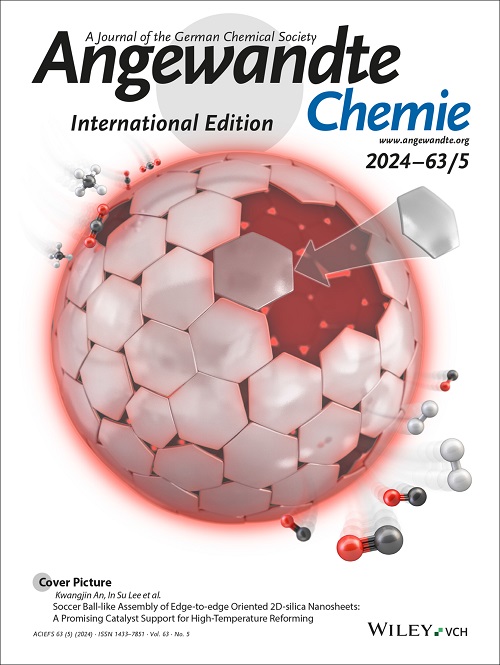Transitioning Room-Temperature Phosphorescence from Solid States to Aqueous Phases via a Cyclic Peptide-Based Supramolecular Scaffold
IF 16.1
1区 化学
Q1 CHEMISTRY, MULTIDISCIPLINARY
引用次数: 0
Abstract
Aqueous room-temperature phosphorescence (RTP) materials have garnered considerable attention for their significant potential across various applications such as bioimaging, sensing, and encryption. However, establishing a universally applicable method for achieving aqueous RTP remains a substantial challenge. Herein, we present a versatile supramolecular strategy to transition RTP from solid states to aqueous phases. By leveraging a cyclic peptide-based supramolecular scaffold, we have developed a noncovalent approach to molecularly disperse diverse organic phosphors within its rigid hydrophobic microdomain in water, yielding a series of aqueous RTP materials. Moreover, high-performance supramolecular phosphorescence resonance energy transfer (PRET) systems have been constructed. Through the facile co-assembly of a fluorescent acceptor with the existing RTP system, these PRET systems exhibit high energy transfer efficiencies (>80%), red-shifted afterglow emission (520-790 nm), ultralarge Stokes shifts (up to 450 nm), and improved photoluminescence quantum yields (6.1-30.7%). This study not only provides a general strategy for constructing aqueous RTP materials from existing phosphors, but also facilitates the creation of PRET systems featuring color-tunable afterglow emission.通过基于环肽的超分子支架实现室温磷光从固态到水相的转变
水性室温磷光(RTP)材料因其在生物成像、传感和加密等各种应用领域的巨大潜力而备受关注。然而,建立一种普遍适用的方法来实现水性 RTP 仍然是一个巨大的挑战。在此,我们提出了一种将 RTP 从固态过渡到水相的多功能超分子策略。通过利用基于环肽的超分子支架,我们开发出了一种非共价方法,可在水中将多种有机荧光粉分子分散在其刚性疏水微域中,从而获得一系列水性 RTP 材料。此外,我们还构建了高性能超分子磷光共振能量转移(PRET)系统。通过荧光受体与现有 RTP 系统的简便共组装,这些 PRET 系统表现出很高的能量传递效率(80%)、红移余辉发射(520-790 nm)、超大斯托克斯位移(高达 450 nm)和更高的光致发光量子产率(6.1-30.7%)。这项研究不仅为利用现有荧光粉构建水性 RTP 材料提供了一般策略,还有助于创建具有可调余辉发射颜色的 PRET 系统。
本文章由计算机程序翻译,如有差异,请以英文原文为准。
求助全文
约1分钟内获得全文
求助全文
来源期刊
CiteScore
26.60
自引率
6.60%
发文量
3549
审稿时长
1.5 months
期刊介绍:
Angewandte Chemie, a journal of the German Chemical Society (GDCh), maintains a leading position among scholarly journals in general chemistry with an impressive Impact Factor of 16.6 (2022 Journal Citation Reports, Clarivate, 2023). Published weekly in a reader-friendly format, it features new articles almost every day. Established in 1887, Angewandte Chemie is a prominent chemistry journal, offering a dynamic blend of Review-type articles, Highlights, Communications, and Research Articles on a weekly basis, making it unique in the field.

 求助内容:
求助内容: 应助结果提醒方式:
应助结果提醒方式:


